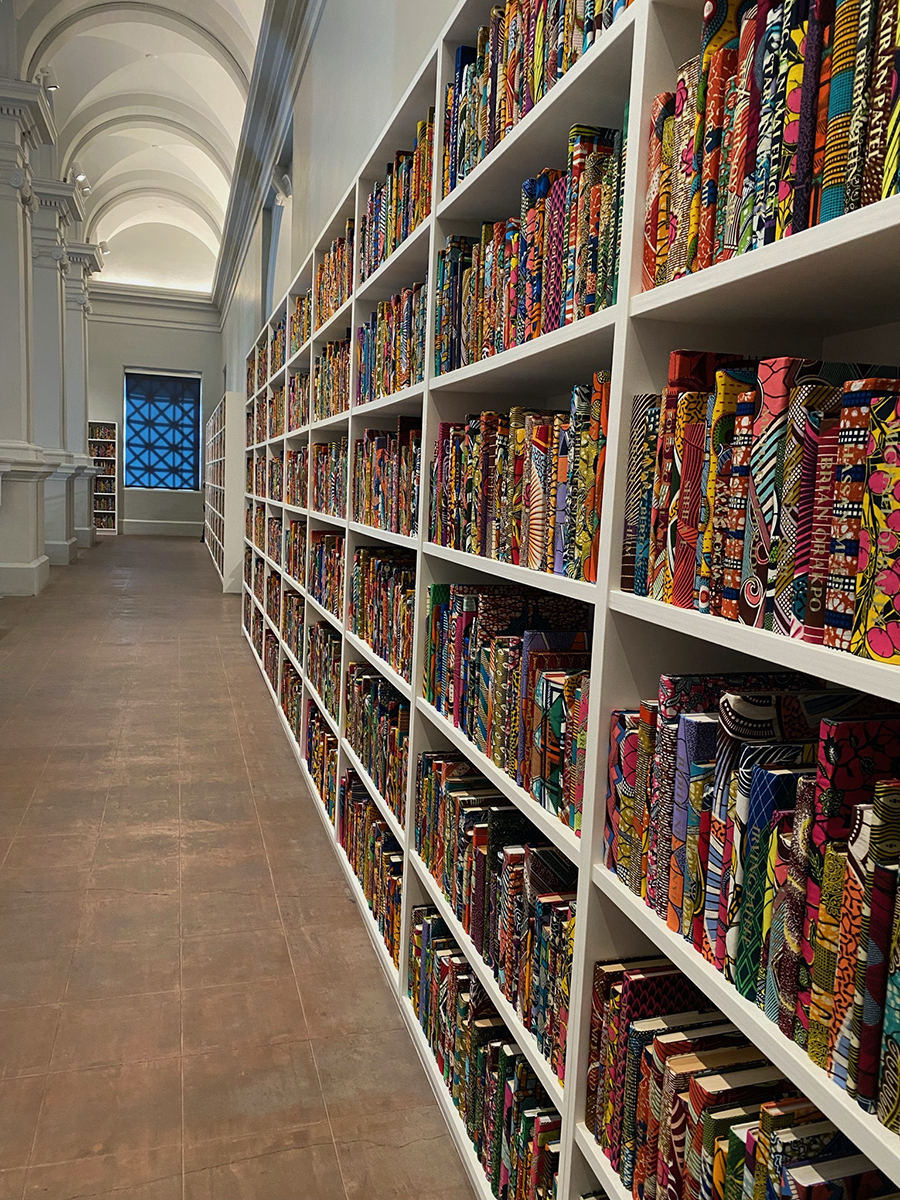When I walked into the Cantor Art Center at Stanford University recently, an installation immediately caught my eye. Ranged along three sides of a large balcony above me were bookcases filled with what looked to be thousands of books bound in bright cloth. As it turns out, there were 6000 books in the exhibition, all wrapped (not bound) in Dutch wax-print fabric. On the spines of some but not all of the books were gold-stamped names in large capital letters, some recognizable (Cameron Diaz, Steve Jobs, Teju Cole, Tiger Woods), some not. The order of the books appeared to be random. I say books, but in fact since they were wrapped we have only the artist Yinka Shonibare’s word about that. The label for this work stated that the names are “first- and second-generation immigrants or their descendants, or those who moved in the Great Migration . . . .”


The label had a complex explanation about the use of Dutch fabric with its Indonesian batik designs, but no explanation for the books, nor does the website (theamericanlibraryinstallation.com) even mention the books beyond stating that the covered objects are, in fact, ‘hardback books.’ This must be a critical piece of information for the artist; what should we as viewers make of this? In the absence of seeing what the actual titles are of these books, a hardback book represents more authority than a paperback: We imagine what is printed in it has more value than its paper counterpart. Since we can can’t touch the books, we can only imagine—but we do—their heft and their permanence. What they have to say is clearly irrelevant since we have no access to that information even if we could pick up the objects.
The artist thought it important to use books as the medium for this particular message, but if I were critiquing this project I would ask, as I have countless times over the decades of my teaching, why the books are there. Sure, stories are told in books, but books as objects also tell their own stories, and if you want to create work that is grounded in the book form, you had better have a clear conceptual pathway toward that making. Otherwise they are merely vehicles, the way, for example, the concept behind Tom Phillips’ iconic altered book project A Humument has circuitously led to legions of books being hacked into fantastic shapes as if they were hunks of soap, or to failed experiments (or ‘artwork’ as Wikipedia labels it) like Jonathan Safran Foer’s Tree of Codes.
In my graduate seminars at Mills College we worked mostly with the codex. Alan Loney, whose The Books to Come (Cuneiform Press, 2012) was a staple of those courses, writes that book = codex + text. While I don’t limit the use of the word book to the codex, I do stress that, in its millennium or so of existence, the codex has not exhausted its possibilities. To explore those possibilities we might begin by reading about the page through the eyes of Bonnie Mak (How the Page Matters, University of Toronto Press, 2012). Mak’s examination of the non-verbal elements of the page and their expressive function is a strong jumping-off point, an initial way to understand the page as both a technological device and a holder of the ‘cultural residue’ of authors, scribes, sellers, owners and readers. Pairing Mak’s exploration of the page with Dick Higgins’ brief essay on the book as a ‘container of provocation’ (Dick Higgins, A Book, 1982) provides a broad basis for conceptualizing the book through the lenses of technology (the hide and reveal of page turning), history and art. Close reading of iconic examples of the codex like Michael Snow’s Cover to Cover, Ed Ruscha’s Twenty-six Gasoline Stations and Sol Lewitt’s Four Basic Kinds of Lines and Colour allows students to follow some pathways that artists have taken to explore the form.
Of course students also did hands-on work to consider the conceptual nature of books. In the next blog post I will describe some of the proof of concept projects that students undertook in the seminars. Had the Shonebare work been available to us, we could have explored that installation through study and practice, perhaps by wrapping and amassing books to test and question the theory behind Shonibare’s approach to his work.
* When you think about it, that category includes nearly everyone in the U.S. Who, after all, would be left, outside of the indigenous peoples of the land (who are not addressed here)?
Kathleen Walkup is Professor Emerita at Mills College. Her research interests focus on the history of women and printing and conceptual practice in artists’ books. In 2022 her exhibition, Possibilities: When artists’ books were young, will open at San Francisco Center for the Book. She is a founding director of the College Book Art Association.

